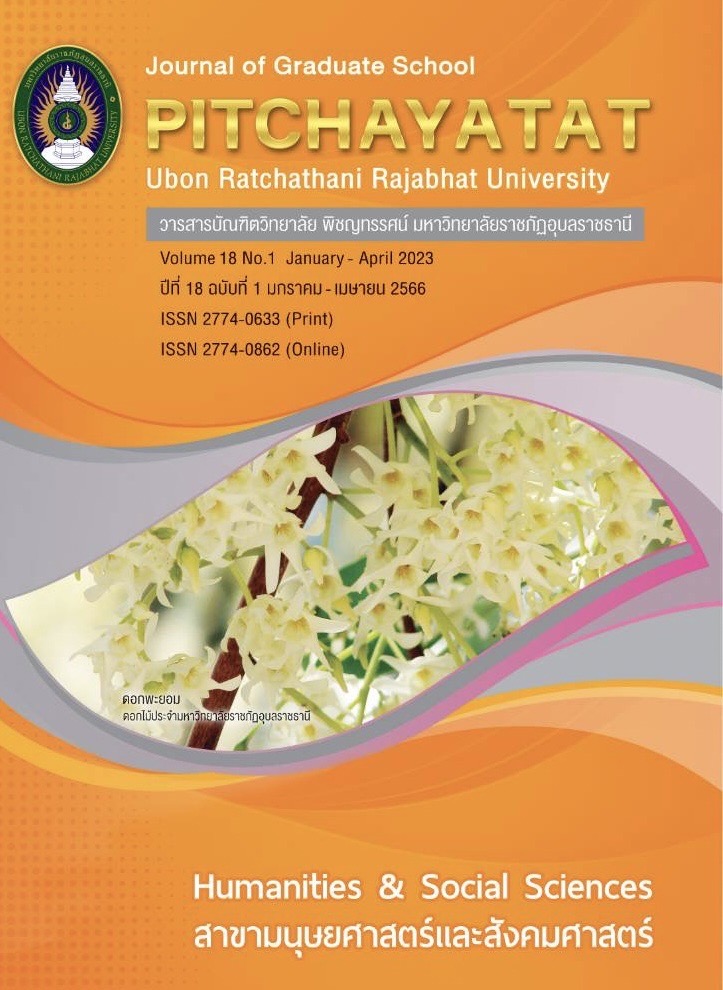การพัฒนาชุดกิจกรรมการอ่านภาษาอังกฤษเพื่อความเข้าใจ โดยใช้กิจกรรมการเติมช่องว่างสำหรับนักเรียนชั้นประถมศึกษาปีที่ 4
บทคัดย่อ
การวิจัยครั้งนี้มีวัตถุประสงค์เพื่อพัฒนาและหาประสิทธิภาพชุดกิจกรรมการอ่านภาษาอังกฤษเพื่อความเข้าใจ โดยใช้กิจกรรมการเติมช่องว่างสำหรับนักเรียนชั้นประถมศึกษาปีที่ 4 ตามเกณฑ์ประสิทธิภาพ 80/80 และเพื่อเปรียบเทียบผลสัมฤทธิ์ทางการเรียนของนักเรียนก่อนและหลังเรียนด้วยชุดกิจกรรมการอ่านภาษาอังกฤษเพื่อความเข้าใจ โดยใช้กิจกรรมการเติมช่องว่าง ตัวอย่างในการวิจัยคือนักเรียนชั้นประถมศึกษาปีที่ 4 โรงเรียนวัดบ่อ (นันทวิทยา) นครปากเกร็ด 1 สังกัดเทศบาลนครปากเกร็ด อำเภอปากเกร็ด จังหวัดนนทบุรี ภาคเรียนที่ 2 ปีการศึกษา 2563 จำนวน 40 คน ได้มาโดยการสุ่มแบบกลุ่ม เครื่องมือที่ใช้ในการวิจัย คือชุดกิจกรรมการอ่านภาษาอังกฤษเพื่อความเข้าใจ โดยใช้กิจกรรมการเติมช่องว่าง จำนวน 6 ชุด และแบบทดสอบวัดผลสัมฤทธิ์ทางการเรียนที่ สถิติที่ใช้ คือ ร้อยละ ค่าเฉลี่ย ส่วนเบี่ยงเบนมาตรฐาน และการทดสอบที
ผลการวิจัยพบว่า
- ชุดกิจกรรมการอ่านภาษาอังกฤษเพื่อความเข้าใจ โดยใช้กิจกรรมการเติมช่องว่างสำหรับนักเรียนชั้นประถมศึกษาปีที่ 4 จำนวน 6 ชุด ประกอบด้วยเรื่อง Hobby Myself Weather Family Food และ School มีประสิทธิภาพ E1/E2 เท่ากับ 82.88/83.33
- นักเรียนที่เรียนด้วยชุดกิจกรรมการอ่านภาษาอังกฤษเพื่อความเข้าใจ โดยใช้กิจกรรมการเติมช่องว่าง มีผลสัมฤทธิ์ทางการเรียนหลังเรียนสูงกว่าก่อนเรียนอย่างมีนัยสำคัญทางสถิติที่ระดับ .01
เอกสารอ้างอิง
ณัฐธิดา สินทิพย์เทวัญ. การเปรียบเทียบความเข้าใจในการอ่านภาษาอังกฤษของนักเรียนชั้นมัธยมศึกษาปีที่ 2 ระหว่างวิธีการสอนอ่านโดยใช้แบบฝึกโคลซกับวิธีการสอนอ่านโดยใช้แบบฝึกตามคู่มือครู. วิทยานิพนธ์ศึกษาศาสตรมหาบัณฑิต มหาวิทยาลัยขอนแก่น, 2551.
ดวงกมล สุจินโน. ผลของการใช้แบบทดสอบโคลซที่มีต่อความเข้าใจการอ่านภาษาอังกฤษแบบตีความของนักเรียนชั้นมัธยมศึกษาปีที่ 4. วิทยานิพนธ์ศึกษาศาสตรมหาบัณฑิต มหาวิทยาลัยเชียงใหม่, 2531.
พรสวรรค์ สีป้อ. สุดยอดวิธีสอนภาษาอังกฤษ. กรุงเทพฯ: อักษรเจริญทัศน์, 2550.
สุมิตรา อังควัฒนากุล. วิธีสอนภาษาอังกฤษเป็นภาษาต่างประเทศ. กรุงเทพฯ: จุฬาลงกรณ์มหาวิทยาลัย, 2540.
สุกิจ ศรีพรหม. “ชุดการสอนกับผลสัมฤทธิ์ทางการเรียน,” วารสารวิชาการ. 41, 8 (2541): 70.
เสาวนีย์ แซ่ภู่. การสร้างแบบฝึกแบบโคลซ เพื่อพัฒนาความเข้าใจในการอ่าน ภาษาไทยของนักเรียนชั้นประถมศึกษาปีที่ 2 (ช่วงชั้นที่ 1). วิทยานิพนธ์การศึกษาศาสตรมหาบัณฑิต มหาวิทยาลัยศรีนครินทรวิโรฒ, 2547.
พงษ์ศักดิ์ ศิริวงศ์. การพัฒนาแบบฝึกทักษะการอ่านจับใจความวิชาภาษาไทยสำหรับนักเรียนชั้นประถมศึกษาปีที่ 6. วิทยานิพนธ์ครุศาสตรมหาบัณฑิต สถาบันราชภัฏอุบลราชธานี, 2549.
พิมรดา แสงภารา, สมนึก ภัททิยธนี และโสภี อุ่นทะยา. การเปรียบเทียบคุณภาพแบบทดสอบโคลซในการวัดความเข้าใจในการอ่านภาษาไทยของนักเรียนชั้นประถมศึกษาปีที่ 6. วิทยานิพนธ์การศึกษามหาบัณฑิต มหาวิทยาลัยมหาสารคาม, 2558.
Fallahi, S., Aziz Malayeri and A. Bayat. “The Effect of Implementing Information-gap Tasks on EFL Learners’ Reading Comprehension Ability,” International Journal of Educational Investigations. 2, 4 (April 2015): 184-194.
Stewart, Summer. CAE Reading Section: Gapped Text Questions. (online) (cited 22January 2019), Available from: https://study.com › Courses › Foreign Language Courses
Ur, Penny. A Course in Language Teaching. Cambridge University Press: Cambridge, 1996.
ดาวน์โหลด
เผยแพร่แล้ว
รูปแบบการอ้างอิง
ฉบับ
ประเภทบทความ
สัญญาอนุญาต
ลิขสิทธิ์ (c) 2023 วารสารบัณฑิตวิทยาลัย พิชญทรรศน์ มหาวิทยาลัยราชภัฏอุบลราชธานี

อนุญาตภายใต้เงื่อนไข Creative Commons Attribution-NonCommercial-NoDerivatives 4.0 International License.
บทความทุกเรื่องได้รับการตรวจความถูกต้องทางวิชาการโดยผู้ทรงคุณวุฒิภายนอกอย่างน้อย 2 คน ความคิดเห็นในวารสารบัณฑิตวิทยาลัย พิชญทรรศน์ มหาวิทยาลัยราชภัฏอุบลราชธานี เป็นความคิดเห็นของผู้เขียนมิใช่ความคิดเห็นของผู้จัดทำ จึงมิใช่ ความรับผิดชอบของบัณฑิตวิทยาลัย มหาวิทยาลัยราชภัฏอุบลราชธานี และบทความในวารสารบัณฑิตวิทยาลัย พิชญทรรศน์ มหาวิทยาลัยราชภัฏอุบลราชธานี สงวนสิทธิ์ตามกฎหมายไทย การจะนำไปเผยแพร่ต้องได้รับอนุญาตเป็นลายลักษณ์อักษรจากกองบรรณาธิการ






